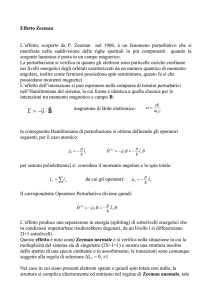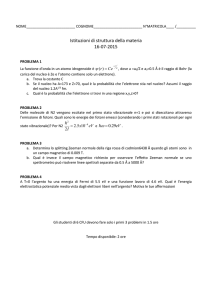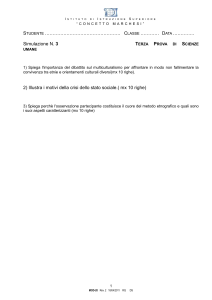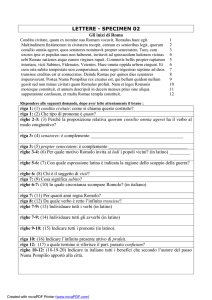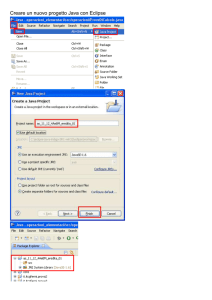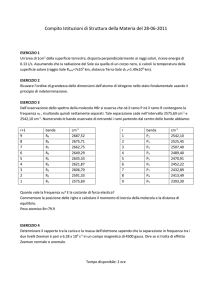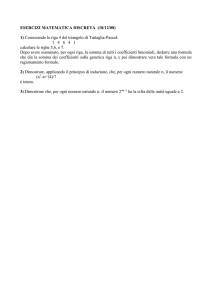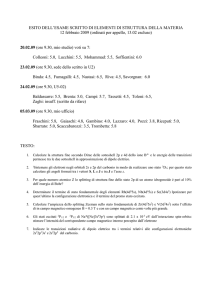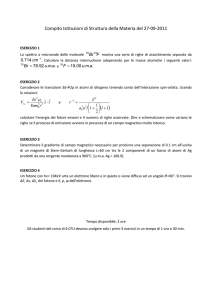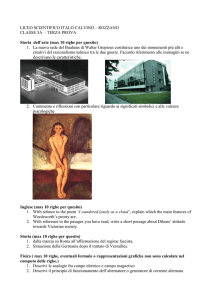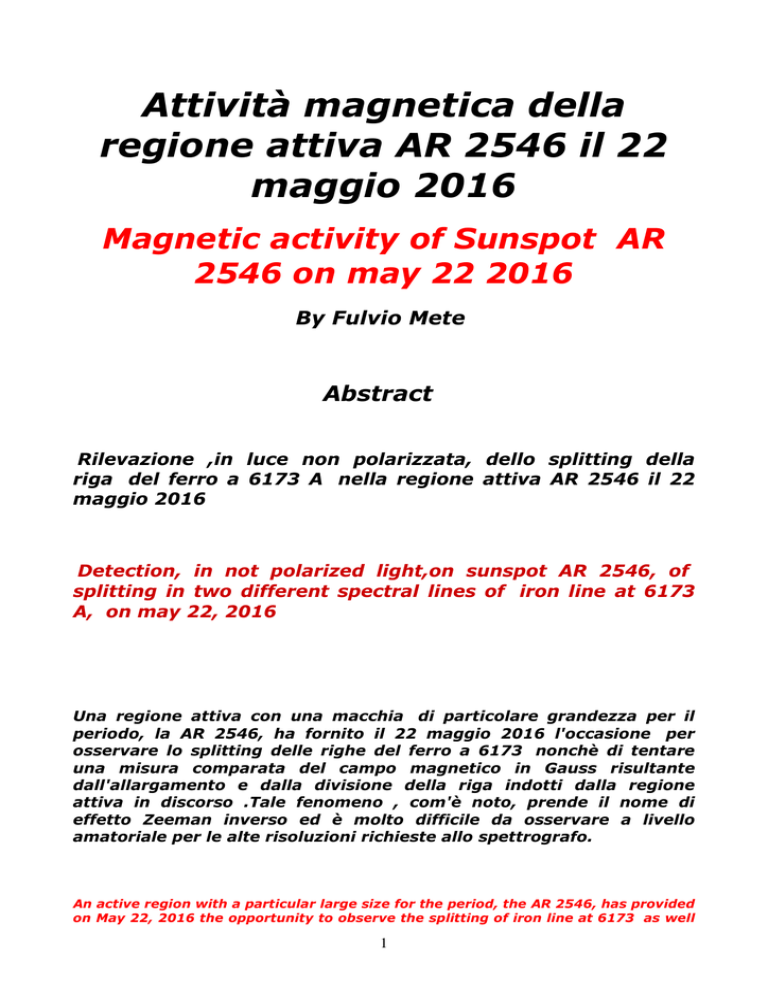
Attività magnetica della
regione attiva AR 2546 il 22
maggio 2016
Magnetic activity of Sunspot AR
2546 on may 22 2016
By Fulvio Mete
Abstract
Rilevazione ,in luce non polarizzata, dello splitting della
riga del ferro a 6173 A nella regione attiva AR 2546 il 22
maggio 2016
Detection, in not polarized light,on sunspot AR 2546, of
splitting in two different spectral lines of iron line at 6173
A, on may 22, 2016
Una regione attiva con una macchia di particolare grandezza per il
periodo, la AR 2546, ha fornito il 22 maggio 2016 l'occasione per
osservare lo splitting delle righe del ferro a 6173 nonchè di tentare
una misura comparata del campo magnetico in Gauss risultante
dall'allargamento e dalla divisione della riga indotti dalla regione
attiva in discorso .Tale fenomeno , com'è noto, prende il nome di
effetto Zeeman inverso ed è molto difficile da osservare a livello
amatoriale per le alte risoluzioni richieste allo spettrografo.
An active region with a particular large size for the period, the AR 2546, has provided
on May 22, 2016 the opportunity to observe the splitting of iron line at 6173 as well
1
as of a comparative measurement of the magnetic field in Gauss resulting from
enlargement and from the splittingof the line induced by this active region .This
phenomenon, as we know, it is called the inverse Zeeman effect and it is very
difficult to observe at amateur level for high resolutions requested to the
spectrograph.
Un breve richiamo sull'effetto Zeeman inverso
A brief note on inverse Zeeman effect
Nella maggior parte degli atomi, esistono diverse configurazioni
elettroniche che possiedono la medesima energia, quindi le transizioni
tra differenti coppie di configurazioni corrispondono a una
singola linea spettrale. La presenza di un campo magnetico esterno
provoca la separazione dei livelli energetici, interagendo in modo
differente con gli elettroni in funzione dei differenti numeri quantici e
modificando leggermente le loro energie. Il risultato è che da differenti
configurazioni che possiedono la stessa energia si ottengono energie
leggermente diverse, che producono linee spettrali molto ravvicinate.
L'effetto Zeeman inverso consiste nell'allargamento o la divisione in
più parti di una riga spettrale per effetto di una campo magnetico. In
astrofisica, l'astronomo americano George Ellery Hale fu il primo ad
osservare tale effetto sul campo magnetico delle macchie solari.Oggi lo
stesso effetto viene sfruttato per ottenere magnetogrammi della
superficie solare.
Più in particolare si può definire l'Effetto Zeeman come il fenomeno
fisico collegato alla scomposizione dei livelli atomici di energia o delle
righe dello spettro dovuta all'azione di un campo magnetico
esterno.Pieter Zeeman, il fisico olandese che vinse nel 1902 il premio
Nobel per la scoperta dell'effetto che da lui prese il nome, si accorse
sperimentalmente che, in presenza di un campo magnetico orientato
perpendicolarmente, alcune righe spettrali si scomponevano in tre
2
righe diverse (effetto Zeeman ortogonale) mentre con un campo
magnetico orientato
parallelamente all'oggetto le righe della
scomposizione erano due, e quella centrale scompariva (effetto
Zeeman longitudinale).Successivamente ci si rese conto che la
scomposizione era molto più complessa di quanto apparisse e, in
relazione allo spin dell'elettrone si parlò di effetto Zeeman anomalo o
normale.Se la riga è in emissione si parle di Effetto diretto, mentre se
è in assorbimento, di effetto Zeeman inverso.
Dal punto di vista dell'astronomia amatoriale, il fenomeno in questione
è molto difficile da osservare per il semplice fatto che richiede poteri
risolutivi spettrali molto elevati (a mio avviso > 60.000) ed una certa
dimestichezza con le righe dello spettro solare per l'individuazione
delle righe del ferro interessate al fenomeno, tra cui in primis quelle
Fe1 a 6173 ed a 6302 A.La registrazione dell'effetto Zeeman sulle
righe solari costituisce quindi una vera sfida per l'amatore che si
occupa di spettroscopia e per la sua strumentazione.
In most of the atoms, there are various electronic configurations that have the same
energy, then the transitions between different pairs of configurations correspond to
a single spectral line. The presence of an external magnetic field causes the
separation of the energy levels, interacting differently with the electrons as a
function of the different quantum numbers and slightly modifying their energies. The
result is that for different configurations that have the same energy are obtained
slightly different energies, that produce closely spaced spectral lines.The Zeeman
effect consists in widening or in the division into more parts of a spectral line due to
a magnetic field. In astrophysics, the American astronomer George Ellery Hale was
the first to observe such an effect on the magnetic field of the sunspots .Today this
effect is exploited to obtain magnetograms of the solar surface.More specifically you
can define the Zeeman effect as the physical phenomenon linked to the breakdown
of atomic energy levels or spectral lines due to the action of a magnetic field .Pieter
Zeeman, Dutch physicist who won the Nobel Prize in 1902 for the discovery of the
effect which bears his name, noticed experimentally that, in the presence of a
magnetic field oriented perpendicularly, some spectral lines were blown to pieces in
three different lines (Zeeman effect orthogonal) while with a magnetic field
oriented parallel to the subject the lines of the decomposition were two, and the
middle one disappeared ( longitudinal Zeeman effect).Subsequently it was
realized that the splitting was much more complex than it appeared and, in relation
to the electron spin was talk of anomalous or normal Zeeman effect .If the line is in
emission, we have a direct Zeeman effect, while if it is in absorbtion, we speak of
inverse Zeeman effect .
From the point of view of amateur astronomy, the phenomenon in question is very
difficult to observe for the simple fact that requires very high spectral resolution
powers (in my opinion> 60,000) and a certain familiarity with the lines of the solar
spectrum for the identification of iron lines more affected to the phenomenon,
including primarily those at 6173 and 6302 A.Then recording Zeeman effect on the
solar lines is thus a real challenge for the amateur who deals with spectroscopy and
hisinstrumentation.
3
L'osservazione del 22 maggio 2016
The observation of may, 22 , 2016
1- Il target
Nella seconda metà di maggio 2016 è apparsa sul sole una regione
attiva piuttosto intensa,numerata 2546, con una macchia di grande
estensione, sicuramente la maggiore dell'anno, in un gruppo
multipolare con un componente molto esteso altri componenti
estremamente più piccoli.
In the second half of May 2016 it appeared an active region on the sun rather
intense, with a spot of great extent, certainly the biggest of the year, in a multi-polar
group with a very large component of other extremely smaller components.
4
La macchia 2546 a livello fotosferico il giorno 22 maggio 2016 , fonte
SOHO-MDI
The sunspot at photospheric level (SOHO-MDI)
5
La macchia 2546 a livello cromosferico- foto dell'autore
The sunspot 2546 in cromosphere: photo of the author
2 - La strumentazione usata
The Equipment used
La strumentazione usata è stato lo spettrografo-spettroelioscopio
digitale ad alta risoluzione Solarscan, sviluppato da chi scrive e dalla
nota ditta Avalon di Aprilia (RM):Si tratta di uno strumento di alta
qualità tecnologica e meccanica completamente automatizzato e
remotizzabile, capace di risoluzioni superiori a 60000 in un peso di 15
Kg e una lunghezza di circa 110 cm, quindi perfettamente gestibile da
una sola persona su montature di classe media come Losmandy G11 ed
Avalon M1.Nel caso specifico lo strumento è stato montato su una
Losmandy G11.La camera usata è stata una Imaging Source DMK 41
AS, con sensore Sony ICX 205 AL e pixel da 4.65 micron, con la quale è
stato ottenuto un filmato dello spettro di 800 frames mediati con
Registax senza alcuna forma di elaborazione (solo stacking).
6
The equipment used was the high resolution spectrograph-digital spectrohelioscope
Solarscan, developed by writer and known firm Avalon of Aprilia (RM): It is a fully
automated and high technological quality instrument and capable of resolutions
higher than 60000 in a weight of 15 kg and a lenght of about 110 cm, therefore
perfectly manageable by one person on medium-class mount as Losmandy G11 and
Avalon M1.The camera used has been an Imaging Source DMK 41 AS, with a ICX 205
AL Sony sensor and 4.65 micron pixels, by which was obtained a video of spectrum
of
800
frames
,stacked
by
Registax
with
no
kind
of
processing
Lo spettrografo Solarscan sulla Losmandy G11 dell'autore
Solarscan Spectrograph on the Losmandy G11 mount of the author
7
Per ottenere la massima risoluzione utile senza che il tranversalium
(le righe orizzontali dovute a diffrazione od imperfezioni della
fenditura) rovinassero lo spettro, la fenditura è stata chiusa a circa
0.15 micron (1/67 di mm) e la messa fuoco è stata particolarmente
curata. La dispersione è stata di 0.021 A/pixel e la risoluzione di circa
60.000 nella zona spettrale interessata .Lo spettro bidimensionale
della riga Fe1 a 6173 A si presentava come segue
For maximum useful resolution without the tranversalium (horizontal lines due to
diffraction or imperfections of the slit) could ruine the spectrum, the slit was closed
at about 0.15 microns (1/67 mm), and the focus has been particularly cared
.Dispersion was of about 0.021 A/pixel and resolution 60.000 in the spectral zone,
and the two-dimensional spectrum of FE1 line at 6173 A was as follows
3 - La scomposizione della riga Fe1 a 6173 A
The splitting of the line Fe 1 at 6173 A
8
Lo splitting si notava su buona parte delle righe del ferro presenti nella
zona , ma sulla riga 6173 era particolarmente accentuato e visibile
sulle due ali ,ed un leggero filtro wavelet lo ha reso ancora più
evidente
The splitting was visible on most part of iron lines, but on the line 6173 was much
more visible both on the blue and red wing, and a light wavelet filter made it more
evident
E, ingrandendo:
and,zooming:
9
La riga con i centri delle due righe splittate
Si trattava quindi di un effetto Zeeman inverso longitudinale; e da esso
si poteva risalire al campo magnetico in Gauss della macchia che lo
aveva generato usando un'apposita formula, a patto di poter
determinare con esattezza le dimensioni in Angstrom dello splitting
della riga.Ho cominciato quindi a selezionare , in Visual Spec, nello
spettro bidimensionale originario ottenuto, la parte relativa all'ombra
e penombra della macchia, ottenendo il profilo seguente:
It was therefore a reverse longitudinal Zeeman effect, and it could be traced back to
the magnetic field in Gauss of the sunspot that had generated it using a special
formula, assuming that one can define exactly the angstrom size of splitting of the
line. Then I began to select, in Visual Spec, in the original two-dimensional spectrum
obtained, the part on the umbra and penumbra of the sunspot, getting the following
profile:
10
11
Tale profilo, non mi dava ,tuttavia la possibilità di distinguere con
precisione lo sdoppiamento della riga, e, ricorrendo alla FWHM od alla
EW si ottenevano risultati ambigui e sfalsati.
Such a profile did not give me, however, the way to distinguish the splitting of the
line with the precision required, and, using the FWHM or to EW were obtained biased
results.
4- La misura della scomposizione della riga nei
due elementi
The measurement of the splitting of the line in two
elements
4 a - La penombra
4 a – Penumbra
Ho allora provato , sullo spettro bidimensionale col filtro wavelet , ad
effettuare il binning sulle regioni al confine tra ombra e penombra
della macchia,sopra e sotto l'ombra stessa, nella quale lo splitting era
più evidente, ottenendo i profili che seguono, nei quali lo
sdoppiamento della riga era misurabile.
I then tried ,in the two-dimensional spectrum with wavelet filter, to perform binning
on the regions on the border between umbra and penumbra of the sunspot,up and
down the umbra where the splitting was more evident, getting the profiles that
follows, in which the splitting itself was measurable .
12
13
Si trattava ora di misurare lo splitting in Angstrom con Visual Spec,
ricorrendo alla routine "line center" nel menù a tendina "Computation
preferences" del menu " Spectrometry".La distanza molto piccola tra le
due righe rendeva tuttavia estremamente facile la possibilità di errori,
per cui ho ritenuto opportuno mediare tre misure del centro riga sulla
riga a destra, verso il blu, e tre su quella a sinistra, verso il rosso.Tale
procedura è stata effettuata sia per lo sdoppiamento sopra l'ombra che
al disotto dell'ombra.Sopra l'ombra il risultato della media è stato il
seguente: 6173.2499 A (blu) - 6173.4219 (rosso)e la differenza tra i
due valori è stata quindi pari a 0.172 A.Sotto l'ombra la separazione
(mediata) è stata di 6173.252 A (blu) - 6173.419 (rosso) e la
differenza tra i due valori è stata quindi pari a 0.167 A. Ho allora
effettuato la media tra i due valori, ottenendo un delta lambda medio
complessivo (da una parte e dall'altra rispetto al centro riga) pari
a 0.169 A.Tale valore va diviso per due per ottenere il D lambda
effettivo di 0.0845 A da applicare alla formula
Potevo passare ora conosciuto il delta lambda sul confine ombrapenombra ,alla fase successiva di misurazione del relativo campo
magnetico.
It was time to measure the splitting in Angstrom with Visual Spec, resorting to the
routine "center line" in the dropdown menu "Computation preferences" of
"Spectrometry" menu .The very small distance between the two lines, however,
made extremely easy the possibility of errors , so I thought it appropriate to
average three measures of the center of line on the line on the right, toward blue,
and three on the one on the left, toward the red , for both the two profiles.The result
of the average was as follows: 6173.2499 A (blue) - 6173.4219 (red) up the umbra,
and 6173.252 (blue) and 6173.419 (red) under the umbra. The difference between
the first two values was equal to 0.172 A,and that of the second two values of 0.167
A.The further average of this two values, equal to 0.169 A gave a sufficient
affordable value of overall delta lambda (from a side to the other respect to the
center of the line) .Such a number must be divided by two to get the effective D
lambda of 0.0845 to apply to the formula.
So, known delta lambda ,I could switch to the next phase of the magnetic field
measurement.
14
15
16
Applicando la formula (3) sul D lambda di 0.0845 e tendo conto che il
fattore di Landè della riga Fe1 a 6173 A è pari a 2.5 ,si ottiene:
Applying the formula (3) and considering that the Landè factor of Fe1 line at 6173 A
is 2.5, I obtained
4 b - Umbra
4b - Umbra
Ho in un primo tempo rinunciato a prendere il profilo spettrale
dell'ombra, che consideravo illeggibile nello spettro bidimensionale,
tuttavia, con mia grande sorpresa, Visual Spec è riuscito ad estrarre
anche dalla zona quasi nera dell'immagine un profilo, che valuterei con
cautela, ma che tuttavia ha sicuramente un considerevole grado di
attendibilità e che mi sento comunque di riportare nella sua
elaborazione.E' bene comunque precisare che la misura dei campi
magnetici nelle ombre delle macchie solari molto scure come quella in
esame non è un compito facile nemmeno per i professionisti, data la
scarsa incisione delle righe splittate e la loro difficoltà di lettura.
I at first declined to take the spectral profile of the umbra, which I considered
illegible in the two-dimensional spectrum, however, to my surprise, Visual Spec
managed to extract even from almost black area of the image a profile, I'd take with
caution , but which it could also have a certain degree of confidence and I feel still to
bring in its elaboration.It 's worth pointing out that the measurement of magnetic
fields in the umbra of the very dark sunspots such as this is not an easy task even for
professionals, given the poor record of splitted lines and their reading difficulties.
17
18
Fatta la solita media di tre misure per entrambe le due righe splittate
nell'ombra, questa era pari a 6137.2479 verso il blu 6137.4537 verso il
rosso.La differenza tra i predetti valori di 0.2058,, divisa per 2 come in
precedenza , era pari a 0.1029 A e, applicando la formula (3),
risultava:
Tale ultimo valore è sicuramente concreto, in quanto deriva da misure
effettuate con un software collaudato e preciso.
19
Tirando le somme, sono stati estratti i valori dei campi magnetici di
ombra e penombra della macchia solare 2546.In ogni caso entrambi i
valori sembrano coerenti tra loro (la differenza è inferiore a 2 pixel
nello spettro bidimensionale) e con il trend della forza dei campi
magnetici delle macchie solari degli ultimi anni, come riportato nelle
recenti pubblicazioni sul tema.
This latter value is undoubtedly less reliable than the last, but certainly not farfetched, as derived from measurements made with a proven and accurate software.
Summing up, they extracted the values of the magnetic fields of umbra and
penumbra of the sunspot 2546 and, if you want to make an average between them,
this would be 2106 Gauss.In any case both values seems consistent with the trend of
the strenght the magnetic fields of sunspots in recent years, as reported in recent
publications
on
the
topic.
Sembrerebbe tutto finito,ma occorre anche considerare i numerosi
fattori di errore, presenti nelle riprese professionali, figuriamoci in
quelle amatoriali.
Dette fonti di errore possono così riassumersi:
1- Seeing
Nel giorno della ripresa ci fu un seeing medio,dovuto ad assenza di
vento e la stessa e stata effettuata alle prime ore del mattino, 7.48
TU quando i moti convettivi di origine termica dovuti al riscaldamento
dell'aria erano minimi, quindi è possibile affermare che l'allargamento
delle righe dovuto al seeing fu senz'altro trascurabile.La fenditura
molto chiusa ha inoltre contribuito non poco al risultato come si può
anche osservare dalla parte superiore della riga nell'immagine che
segue.
2- Fenditura
Molto più del seeing contano, a mio avviso, gli errori dovuti alla
chiusura della fenditura a 15 micron, osservabili nell'immagine
sottostanteTali errori sono assolutamente inevitabili quando si usano
fenditure commerciali (quelle professionali da ricerca vanno lavorate
almeno ad 1/4 di Lambda e costano migliaia di euro). Del resto una
chiusura della fenditura a 15 micron, e quindi molto stretta, come
quella in esame ha fornito già un risultato molto buono ed ha
permesso da sola il raggiungimento della risoluzione necessaria per
osservare lo splitting.Tanto per intenderci , una chiusura a 30 micron
20
ed un risoluzione conseguentemente dimezzata non avrebbe permesso
di osservare il fenomeno e tanto meno quantizzarlo con
precisione.Relativamente all'errore in questione,questo appare molto
contenuto nelle zone di binning e peraltro compensato dalle medie
effettuate .
21
3- Errori di inseguimento della montatura:
la modesta durata del filmato (ca 1 minuto) hanno reso trascurabile
l'errore, sempre presente in montature commerciali specie in alta
risoluzione.
4-Effetto Evershed che provoca una deformazione dell'assorbimento
nella zona di penombra della macchia:
Non dovrebbe essere percepibile se non per risoluzioni d lambda
superiori a 2/100 (0.02) A, mentre si aggira sui 0.10 A.
5-Errore del software usato, dovuto in parte all'inclinazione delle righe
dello splitting nella zona di penombra.
In conclusione, una quantizzazione di tali fattori di errore
separatamente presi appare molto difficile in questa sede, si può
tuttavia prendere in considerazione un errore assoluto statistico
complessivo derivante dalla metà della differenza tra i valori massimo
e minimo delle medie dei centri delle righe splittate (0.172-0.167)/2
pari a 0.0025 A, a sua volta equivalente a 56 Gauss.Potrei quindi dire
che il valore del campo magnetico della macchia è pari a 1899 +- 56
Gauss per la penombra. Stesso discorso per l'ombra, dove però
vanno considerate solo le differenze tra i massimi e minimi delle tre
misure dei centri riga nel blu e nel rosso (0.095 e 0.025) la cui
differenza divisa per 2, pari a 0.0035 A, equivale a 79 Gauss circa.La
forza del campo nell'ombra dovrebbe quindi valere 2313 +- 79
Gauss
It would appear all over, but we must also consider a number of error factors,
present
in
professional
detection,
let
alone
in
those
of
amateurs.
Such sources of errors can be summarized as follows:
1-Seeing
On the day of the shooting there was an average seeing, due to lack of wind and the
same was carried out in the early hours of the morning, 7:48 UT when the convection
fluxes of air of thermal origin due to the warming were minimal, so you can say that
enlargement of the lines due to the seeing was certainly negligible.The slit very
closed also contributed greatly to the result as can be observed from the top of the
line in the image below.
22
2-Slit
More of seeing matter, in my opinion, the errors due to the closure of the slit to 15
microns, observable in the upper image .Such errors are absolutely unavoidable
when using commercial slits (those ranging from professional research work at least
1/4 Lambda and costing thousands of Euros). Moreover a very narrow 15 micron
slit, such as this has already provided a very good result and has allowed to achieve
the resolution necessary to observe the splitting of the line. For instance, a closure to
30 microns of the slit and a consequent lower resolution would not let us watch the
phenomenon.Anyway this error looks very small in binning areas and partially
offset by the average performed above and below the umbra.
3-Tracking error of the mount:
the short duration of the movie (about 1 minute) have made negligible error.
4-Effect Evershed
It should not be perceived except by d lambda resolutions greater than 2/100 (0.02)
A, while ours is about 12:10 A.
5-Error of the software used, in part due to the inclination of the lines of splitting in
penumbral zone.
In conclusion, a quantization of these factors of error taken separately appears very
difficult here, you may, however, take into account an overall absolute error from
half the difference between the maximum and minimum values of the averages of
the centers of splitted lines (0.172- 0.167) / 2 equal to 0.0025 A, equivalent to 56
Gauss.I could then say that the value of the magnetic field of penumbra of the
sunspot is equal to 1899 + - 56 Gauss.Same goes for the umbra, where, however,
should be considered only the differences between the highest and lowest data of
the three centers of the line measurements in the blue and red (0.095 and 0.025)
whose difference divided by 2, of 0.0035 A, is equivalent to about 79 Gauss. the
strength of the field in the umbra should then amount to 2313 + - 79 Gauss
5 - Il confronto del risultato con gli articoli
scientifici sulla questione
5 - The comparison of the result with scientific articles about
the topic
Si è acceso negli ultimi anni un approfondito dibattito sulla ricerca
effettuata da Penn e Livingston nel 2011 sui dati forniti dal NSO Kitt
Peak McMath-Pierce telescope sullo splitting Zeeman della riga Fe 1 a
15648 A, che, ad avviso dei predetti , mostravano un costante calo nei
23
valori in Gauss dei campi magnetici delle ombre delle macchie solari
durante il ciclo 23 e l'inizio del 24, al punto da far ritenere, perdurando
il trend, la quasi totale scomparsa della macchie nel corso del ciclo 25.
Una successiva ricerca di Fraser Watson (NSO) nel 2014 sui dati MDI,
HMI e BABO sviluppò il trend risultante nell'immagine sottostante:
24
La ricerca di Penn e Livingstone sembra poi essere stata confutata da
dati più recenti,(Reza Rezaei ed altri) che , sulle righe del Fe1 nell'IR
vicino, mostrano che la diminuzione della forza dei campi magnetici è
molto più contenuta delle valutazioni di Penn e Livingstone o
addirittura non esiste affatto.
25
Il valore di B dell'ombra dell'AR 2546 da me trovato risulta
abbastanza compatibile con i dati più recenti del 2016 sul ciclo 24 di
Reza Rezaei e completamente compatibile col trend risultante
dall'indagine di Fraser Watson , piuttosto che con il trend proposto da
Penn e Livingstone, come si può osservare dall' elaborazione delle
precedenti immagini con la mia osservazione contrassegnata da un
pallino viola.Naturalmente si tratta di un solo dato, ricavato nel visibile
e con una strumentazione amatoriale, ma è comunque un contributo,
forse utile in un momento in cui la dinamica dei campi magnetici solari
sembra non seguire i trend previsti.
The value of B in umbra of AR 2546 which I found is quite compatible with the most
recent results on the 24-cycle and fully compatible with the trend resulting from the
survey of Watson on MDI , HMI and BABO data, rather than with the trend proposed
Penn and Livingstone, as can be observed from processing of previous images, with
my observation marked by a violet dot .Of course it is a single data, in the visible and
obtained by an amateur equipment, but it is a contribution in a moment in which the
trend of magnetic field in the sunspots seems not to follow the forecasts.
26
27
Appassionato di astronomia dall’età di otto anni,Fulvio Mete ha dedicato buona parte della sua
vita a questa sua passione, integrando le conoscenze di astronomia con quelle di fisica,
informatica, meccanica.Da oltre 15 anni si occupa di spettroscopia astronomica, ha svolto e
svolge numerose iniziative di ricerca, quali spettroscopia di nove e supernove, spettroscopia
solare ad alta risoluzione, imaging nell IR vicino.Ha, altresì, organizzato numerosi eventi di
livello nazionale in tale settore, quali i Seminari di Spettroscopia UAI di Asiago e di Arcetri, e
molti altri di minore livello.Ha pubblicato una dozzina di articoli su riviste commerciali di
divulgazione astronomica (Coelum, Nuovo Orione) ed altri sulla rivista Astronomia UAI,
nonchè su testi stranieri in lingua inglese e francese.Ha partecipato con proprie relazioni a
numerosi Convegni e Congressi di astronomia.Ha progettato e costruito e costruisce da
autodidatta numerosi strumenti per la osservazione e ripresa spettroscopica del sole e degli
oggetti del cielo profondo, alcuni dei quali hanno carattere di unicità a livello nazionale.Ha
ricevuto, dall’Unione Astrofili Italiana ,il “Premio Ruggeri” per la sua attività di astronomo
amatore, partecipa, ed è presente, su buona parte dei Newsgroup nazionali ed
internazionali,ed è ben conosciuto anche tra gli astrofili di altri paesi, in particolare
statunitensi, australiani, francesi ed inglesi, con alcuni dei quali mantiene rapporti nel campo
della spettroscopia amatoriale.
I suoi siti web, dedicati essenzialmente alla spettroscopia ed all’astronomia infrarossa, sono:
http://www.lightfrominfinity.org
http://www.pno-astronomy.com
Amateur Astronomer from age of eight, Fulvio Mete has devoted much of his life to his
passion, by integrating the knowledge of astronomy with those of physics, computer science,
mechanics.After over 15 years dealing with astronomical spectroscopy, he has played and
carries out a number of research initiatives, such as spectroscopy of novae and supernovae,
solar spectroscopy, high-resolution imaging in near IR.He, also organized several national
events in this area, such as spectroscopy Seminars UAI of Asiago and Arcetri , and many other
smaller level.Has published a dozen articles on commercial astronomical disclosure (Coelum
magazine, New Orion) and others in the journal Astronomy UAI, as well as of foreign texts in
English and french.He has participated with its relations to several meetings & Conventions of
28
astronomy.He designed and built by himself several instruments for spectroscopic observation
and shooting of the sun and deep sky objects, some of which are ultimately uniqueHe has
received by the Italian Amateur Astronomers Association (UAI) the "Ruggeri Award" for his
activities of amateur astronomer, participates, and is present over most of the national and
international newsgroups, and is also well known among amateur astronomers in other
countries.
His website, dedicated primarily to spectroscopy and infrared astronomy, are:
http://www.lightfrominfinity.org
http://www.pno-astronomy.com
29

